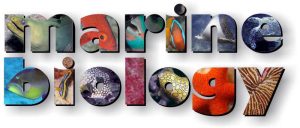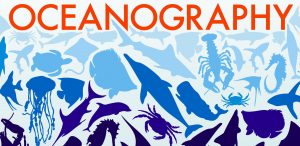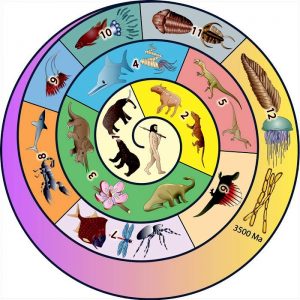– Marine Biology –
Marine biology is the study of marine organisms, their behaviors and their interactions with the environment. Because there are so many topics one could study within the field, many researchers select a particular interest and specialize in it.  Specializations can be based on a particular species, organism, behavior, technique or ecosystem. For example, marine biologists may choose to study a single species of clams or all clams that are native to a climate or region.
Specializations can be based on a particular species, organism, behavior, technique or ecosystem. For example, marine biologists may choose to study a single species of clams or all clams that are native to a climate or region.
One area of specialization, the field of marine biotechnology, offers great opportunity for marine biologists. Marine biotechnology research presents a wide range of possibilities and applications. One focus area is the biomedical field, where scientists develop and test drugs, many of which come from marine organisms.
Molecular biology is a related area of specialization in this field. Researchers apply molecular approaches and techniques to many environments, from coastal ponds to the deep sea and many different organisms,  from microscopic bacteria, plants and animals to marine mammals. For example, molecular biology can be used to identify the presence of a specific organism in a water sample through the use of molecular probes. This is very useful when the organism in question is microscopic or similar to other organisms.
from microscopic bacteria, plants and animals to marine mammals. For example, molecular biology can be used to identify the presence of a specific organism in a water sample through the use of molecular probes. This is very useful when the organism in question is microscopic or similar to other organisms.
Aquaculture, the farming of fin-fish, shellfish and seaweeds, is another field that has been aided by marine biotechnology and molecular techniques. Aquaculture is gaining importance in this country as consumer demand for fish and shellfish becomes greater than can be met by traditional commercial fishing. At the same time, technological advances have made aquaculture more economically feasible.
Other popular areas within the field of marine biology are environmental biology and toxicology. Both of these areas have direct applications and implications for our society. Examples of specialties in environmental biology and toxicology include water quality research and the study of contaminants or pollutants in the coastal or marine environment. Laws, regulations and cleanup measures designed to protect the environment will ensure that marine and environmental  biologists and consultants continue to play an important role in our society.
biologists and consultants continue to play an important role in our society.
Another field of research within marine or aquatic biology involves organisms that have been around for billions of years. Protists are singled-celled organisms that include protozoa and micro-algae. Their importance as a group lies in the fact that microscopic algae serve as food for animals in aquatic food webs, earning them the title “primary producers” and since primary producers are mostly microscopic species, the organisms that consume them are often single-celled, microscopic species as well. If something happens to somehow alter populations of primary producers, the entire food web could be affected.
Probably the topic most often asked about within marine biology is research involving marine mammals including cetaceans (whales, porpoises & dolphins) and pinnipeds (sea lions, seals & walruses). The reality is that research jobs involving marine mammals are extremely hard to come by for a number of reasons, including the popularity of the field, the fact that working with marine mammals is highly regulated (most research is done using tissue samples of sick, stranded or dead animals and not on live, healthy animals) and because funding is very competitive.
Two popular fields of research involving marine mammals are bio-acoustics & vocalization (the study of marine mammal sounds) and population dynamics (studying marine mammalian behaviors and responses to environmental conditions as they impact population). As for non-research employment options involving marine mammals, most positions would exist at aquariums, museums and national and international conservation groups, though these are also highly competitive.
– Oceanography –
The major disciplines of oceanography are geological oceanography, physical oceanography and chemical oceanography. Oceanographers and others involved in these disciplines often work together to unravel the mysteries and unknowns of ocean science. In reading about each of these sub-fields, keep in mind that some of the most important oceanographic discoveries have been made as a result of an integrated, multidisciplinary approach often involving geologists, chemists, biologists, physical oceanographers & engineers.
Marine biology is sometimes called biological oceanography and could be included in this section. One distinction that has been made between the fields of marine biology and biological oceanography is this. Marine biologists study the plants, animals and protists of our estuaries, coasts and oceans, ranging from whales to microscopic algae & bacteria and biological oceanographers study marine organisms and their biological processes within  the context of their natural environment.
the context of their natural environment.
As a growing global population stresses the ability of our society to produce food, water and shelter, we will continue to look to the oceans to help sustain our basic needs. Advances in technology combined with demand, will improve our ability to derive food, drinking water, energy sources, waste disposal and transportation from the ocean. It will be up to this and future generations to build upon our existing knowledge of the ocean and its potential to help meet the needs of the world and its inhabitants.
Geological Oceanography
As many interesting geological features as there are on land, nearly as many exist within, under and at the boundaries of the oceans. Mountains, valleys, volcanoes, islands, plains & canyons all exist in similar form in the marine realm. In fact, Earth’s largest continuous mountain chain is the Mid-Ocean Ridge, stretching for over 40,000 miles and rising above the surface of the water in a few places such as Iceland. The Mariana Trench located in the central Pacific Ocean, is deeper by about a mile than the highest point of Mount Everest. Active deep-sea volcanoes located along mid-ocean ridges, supply rich mineral deposits and new rock formations to the seafloor. It has been written that the ocean bottoms are the most active places on Earth from a geological perspective.
Geological oceanographers study the formations, composition and history of the seafloor. They examine sediments, including physical characteristics such as size, shape, color & weight; chemical characteristics, such as composition and how sediments interact with the environment and other factors including sediment age, origin, distribution & transport. They piece together information about how the Earth formed and how the movement of plates and continents results in events such as volcanoes and earthquakes. They work with biologists & chemical oceanographers to learn more about historical climate records and animal and plant life by examining sediment and rock cores for fossils and analyzing sediment composition using radiocarbon dating and other methods. They also use remote sensing technology to map the ridges & valleys.
An increasingly important area of marine geology is coastal geology. Throughout history, the human population has shown a tendency to settle along the world’s 273,000 miles of coastline. The effects of humans inhabiting our shores and coastlines have become increasingly apparent. Coastal pollution and waste disposal are creating problems and costing government & industry billions of dollars in research and remediation efforts. Although the percentage of people living on the coast is expected to remain fairly constant over the next few decades, total numbers are expected to increase as population continues to increase.
In addition to human effects on our shores,  natural coastal processes such as rising sea level, erosion and sediment transport and storm-related events such as flooding, severe erosion and storm over-wash make our coastal areas dynamic environments. Often, humans react by attempting to protect structures situated along the coast including homes, businesses & roads, even when these structures are located on land forms, such as barrier beaches that are “temporary” in a geologic sense of time. To protect these structures, coastal engineers have developed and constructed seawalls, jetties, groins and bridges. More recently, natural or “soft solutions” such as constructed wetlands & salt marshes have been developed to slow the effects of coastal processes. Coastal geologists & coastal engineers working with oceanographers from each of the disciplines, will be instrumental in forming policy and management options to minimize the conflicts between coastal development and natural processes.
natural coastal processes such as rising sea level, erosion and sediment transport and storm-related events such as flooding, severe erosion and storm over-wash make our coastal areas dynamic environments. Often, humans react by attempting to protect structures situated along the coast including homes, businesses & roads, even when these structures are located on land forms, such as barrier beaches that are “temporary” in a geologic sense of time. To protect these structures, coastal engineers have developed and constructed seawalls, jetties, groins and bridges. More recently, natural or “soft solutions” such as constructed wetlands & salt marshes have been developed to slow the effects of coastal processes. Coastal geologists & coastal engineers working with oceanographers from each of the disciplines, will be instrumental in forming policy and management options to minimize the conflicts between coastal development and natural processes.
Physical Oceanography
Most oceanographers try to think of the world’s oceans as one giant system, collectively known as the global ocean. But before space travel and the invention of satellites, it was very hard to actually observe the oceans on such a large scale. Pictures of the global ocean from space have given oceanographers important information about ocean currents, temperatures and other properties. Satellites collect information around the clock and feed it back to individual laboratories & classrooms in real time. This innovation has revolutionized oceanography and given researchers important information about weather and climate, circulation and environmental problems  such as global warming, global circulation, the world’s fisheries decline and harmful algal blooms.
such as global warming, global circulation, the world’s fisheries decline and harmful algal blooms.
Perhaps more than any other group of oceanographers, physical oceanographers have benefited from satellite technology. Because they study the movement of the oceans and the forces that cause motion such as winds, waves & tides, they must look at the ocean from a “big picture” perspective. Shipboard measurements and the development of instruments such as computer programmable buoys that can be left at sea for long periods of time were huge advances for the field of physical oceanography and continue to be important tools, but satellites offer perspectives that early oceanographers may never have dreamed of.
Physical oceanographers study the interaction between the ocean and its boundaries of land, seafloor and atmosphere and the relationship between the sea, weather & climate. Questions about how the oceans work in a physical sense include investigations into water qualities such as temperature, salinity & density and influential factors such as wind speed, air temperature, tides and interaction with nearby land & underwater formations.
Physical oceanographers seek to understand why, where and how water moves on all space and time scales. They are interested as well, in the consequences of these movements. Some physical oceanographers are theoreticians and use computer models to answer questions and form hypotheses about oceanographic processes. Others use observations and increasingly, satellite observations. Understanding the global ocean requires a close partnership between theory, observations and experiments.
Often, physical oceanographers work with their biological, chemical and geological colleagues. Understanding the way the ocean works, physically, supplies oceanographers in the biological, geological, chemical or engineering disciplines with important details they need to answer questions. The physical properties of the ocean are intimately linked to the biology and chemistry of the ocean and vice-versa.
Chemical Oceanography
The ocean has been referred to as a “chemical soup” because it contains many chemical compounds, elements, gases, minerals, and organic  and particulate matter. While water is the most plentiful ingredient, salts are among the most important. Amazingly, despite the major changes that have taken place on Earth throughout history — continental collisions, land formations, glaciation which is the basic composition of seawater that has remained relatively constant for millions of years.
and particulate matter. While water is the most plentiful ingredient, salts are among the most important. Amazingly, despite the major changes that have taken place on Earth throughout history — continental collisions, land formations, glaciation which is the basic composition of seawater that has remained relatively constant for millions of years.
Chemical oceanographers, also called marine chemists, marine geochemists or even marine biogeochemists, may study one or a combination of the following: formation of seawater and seafloor sediments, relationships between chemical compounds (both organic and inorganic), how chemical inputs to the ocean (including pollution) affect it and how the chemistry of the ocean affects or is affected by biological, geological & physical factors. As with the other disciplines of oceanography, chemical oceanographers rely on and interact with researchers from the other disciplines.
One important aspect of chemical oceanography is the study of pollutants. This work may lead chemical oceanographers to the deep ocean, coastal bays and estuaries or inland rivers, streams and lakes. Sources of pollutants range from the obvious (sewage, oil or fuels, ocean dumping) to sources that are harder to detect or trace (agricultural or lawn runoff containing chemical fertilizers, leaking septic systems, road runoff or storm drain overflows). Chemical oceanographers study the impact of such pollutants by examining how they interact with seawater, marine life & sediments. Chemicals and pollutants introduced to a marine environment may behave very differently depending on environmental conditions such as salinity, wind, rainfall, temperature and transport methods. Transport methods include land-based (for example, surface runoff or groundwater), water-based (rivers and streams) and atmosphere-based (rain and dust).
Modern society’s rapid technological advances, including the development of complex chemical compounds and processes used to produce and manufacture energy, food, clothing, medicine and other products, have created a need for chemical oceanographers. In the quest for bigger, stronger and faster, the costs of “improvements” often get overlooked. For example, the disposal of waste that results from products and by-products can be a problem in itself. Who would  have thought that household cleaning products, fertilizers, pesticides, boat paints and leaded fuel — all products that saved time, worked better and often cost less — could have contributed to the degradation of many marine and coastal areas? Fortunately, researchers in many oceanographic disciplines and related areas including marine chemists, have worked together to improve our understanding of such impacts which has in turn, led to improved controls, regulations, testing methods and ultimately, safer products.
have thought that household cleaning products, fertilizers, pesticides, boat paints and leaded fuel — all products that saved time, worked better and often cost less — could have contributed to the degradation of many marine and coastal areas? Fortunately, researchers in many oceanographic disciplines and related areas including marine chemists, have worked together to improve our understanding of such impacts which has in turn, led to improved controls, regulations, testing methods and ultimately, safer products.
The work of chemical oceanographers will continue to provide answers to important questions. For example, the use of the oceans for waste disposal and as a source for drugs and minerals will require cooperative research between ocean chemists, biologists and geologists. It is the work of marine chemists that aids ocean engineers in the development of instruments, vessels and ocean vehicles that, in turn, improve the ability of researchers of all oceanographic disciplines to go to sea, collect data and discover previously unknown formations, marine life and phenomena.
As the population discovers new ways to use the oceans be it for food, transportation, energy or waste disposal, chemical oceanographers will play an important role in improving our knowledge about the impact of these activities on the ocean and its ability to sustain them.
– Ocean Engineering –
Ocean engineering provides an important link between the other oceanographic disciplines such as marine biology, chemical and physical oceanography and marine geology and geophysics. Just as the interests of oceanographers have driven the demand for the design skills and technical expertise of ocean engineers, the innovations in instrumentation and equipment design made by ocean engineers have revolutionized the field of oceanography.
The invention of thousands of oceanographic instruments and devices has changed the way oceanographers study the oceans and coasts. Information that once took years to compile and that frequently involved sampling in harsh weather conditions, can now be accomplished in minutes, often from remote locations including ships and laboratories.  The innovations of ocean engineers have enabled oceanographers to travel farther offshore and deeper into the sea and to stay there for longer periods of time. Because of ocean engineers, major oceanographic discoveries including hydro-thermal vents, ocean volcanoes, thousands of miles of underwater mountain chains, “new” species and biological, chemical, geographical and physical processes & phenomena have been made.
The innovations of ocean engineers have enabled oceanographers to travel farther offshore and deeper into the sea and to stay there for longer periods of time. Because of ocean engineers, major oceanographic discoveries including hydro-thermal vents, ocean volcanoes, thousands of miles of underwater mountain chains, “new” species and biological, chemical, geographical and physical processes & phenomena have been made.
Ocean engineering is actually a combination of several types of engineering: a mix of mechanical, electrical, civil, acoustical and chemical engineering techniques and skills, coupled with a basic understanding of how the oceans work. Not only do ocean engineers design and build instruments that must stand up to the wear and tear of frequent use, they must design instruments that will survive the harsh conditions of the ocean environment. Saltwater is highly corrosive to many materials and high winds, waves, currents, severe storms and marine life fouling (such as barnacles) must also be factored into design plans. It has even been said that the marine environment is more hostile than outer space.
In addition to ocean engineers, technicians play a key role in maintaining and preparing the equipment. It is the responsibility of technicians to make sure that instruments are functioning properly, that they are recording the measurements they were designed to and in some cases, that the information being recorded is relayed back to satellites or computers that may be hundreds or even thousands of miles away.
Coastal engineering has become an increasingly important part of ocean engineering. With more and more people living or working at or near the world’s coasts,  problems associated with coastal development, such as pollution and waste disposal, will require the expertise and innovation of coastal engineers. For example, increasing the capacity of a coastal community to handle the sewage and garbage generated by a growing population requires careful attention to the effect disposal methods will have on the adjacent water bodies. What may work for an ocean-side community may not work for a lakefront or riverfront community. Also waves, rising sea level and storms have a significant impact on coastlines, often causing erosion and loss of coastal property. In efforts to protect coastal structures, coastal engineers are tasked with designing and creating ways to lessen the impact of storms and other natural shoreline processes.
problems associated with coastal development, such as pollution and waste disposal, will require the expertise and innovation of coastal engineers. For example, increasing the capacity of a coastal community to handle the sewage and garbage generated by a growing population requires careful attention to the effect disposal methods will have on the adjacent water bodies. What may work for an ocean-side community may not work for a lakefront or riverfront community. Also waves, rising sea level and storms have a significant impact on coastlines, often causing erosion and loss of coastal property. In efforts to protect coastal structures, coastal engineers are tasked with designing and creating ways to lessen the impact of storms and other natural shoreline processes.
The oil industry, military and marine navigation fields also require ocean engineering skills. Each of these sectors directly impacts our lifestyle in some way, be it a source of energy, transportation or our nation’s defense. The work of ocean engineers plays an important role in each of these employment sectors. Because technology is central to the field of ocean engineering, future career prospects seem promising and as the role of the ocean continues to gain the interest of business, government and the private sector, the demand for ocean engineers should grow.